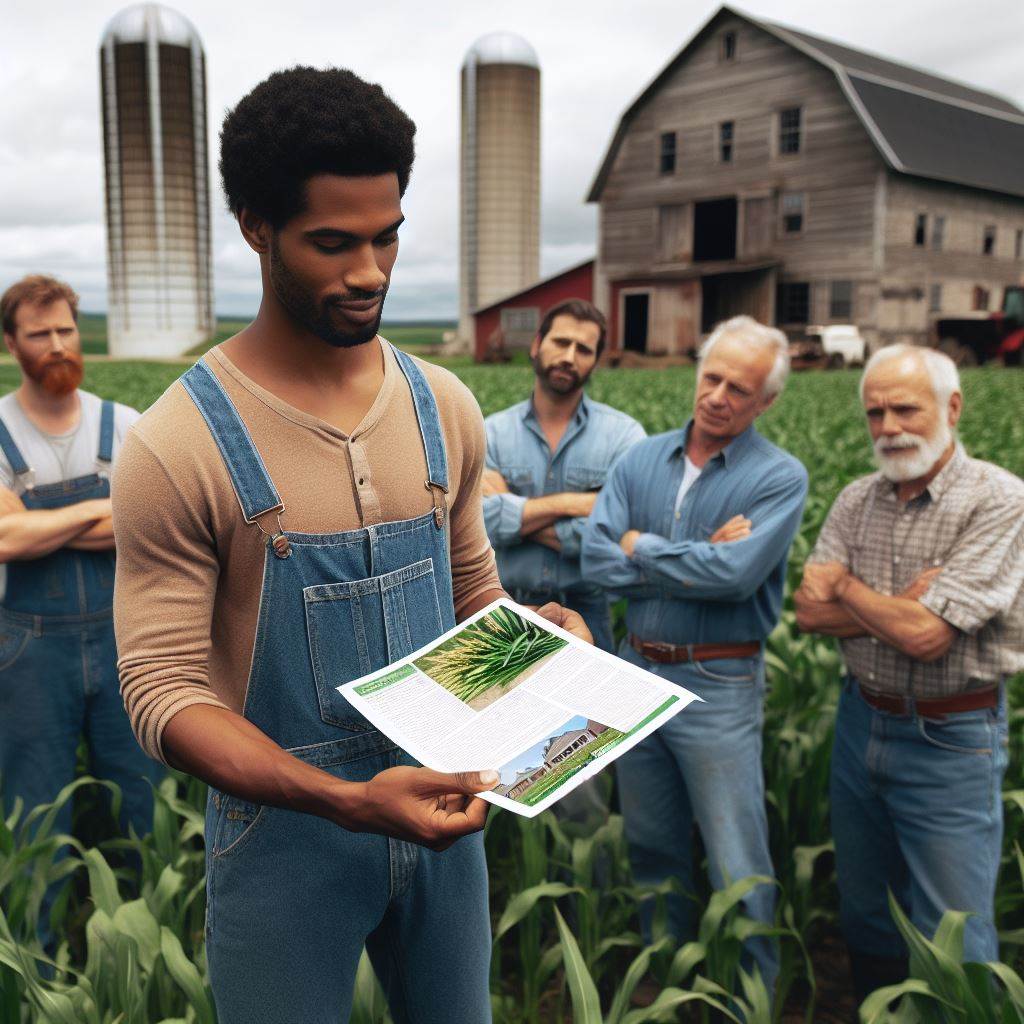Introduction
Farm subsidies are financial aids provided to farmers by the government to support agricultural production and ensure stability.
Staying updated on the latest subsidies is crucial for farmers to maximize benefits and remain competitive.
In this blog post, we’ll explore the newest developments in farm subsidies for the year 2024.
We’ll discuss changes in subsidy programs, eligibility criteria, and application processes to help farmers navigate the updates effectively.
Additionally, we’ll highlight the importance of understanding how these subsidies impact agricultural operations and rural economies.
By staying informed, farmers can make informed decisions to optimize their use of subsidies and adapt to evolving agricultural policies.
Let’s delve into the details of the latest farm subsidies and their implications for farmers in 2024.
Overview of Farm Subsidies in 2024
Brief history of farm subsidies
Farm subsidies have a long-standing history and serve as a significant support system for farmers.
Introduced during the Great Depression, these subsidies aimed to stabilize the agricultural sector by shielding farmers from adverse market conditions.
Throughout the years, farm subsidies have evolved to include various forms of financial assistance, such as direct payments, crop insurance, and conservation programs.
Current status of farm subsidies
In 2024, farm subsidies still hold great importance in sustaining and promoting agricultural activities.
The government implements several programs to provide financial aid to farmers for different purposes.
The most common form of subsidy is commodity subsidies, which ensure a stable income for farmers growing various crops.
These subsidies help to offset the risks associated with fluctuating market prices and unpredictable weather conditions.
In addition to commodity subsidies, market access programs are also crucial.
Transform Your Agribusiness
Unlock your farm's potential with expert advice tailored to your needs. Get actionable steps that drive real results.
Get StartedThese initiatives facilitate agricultural exports by improving market opportunities for farmers.
By promoting international trade, these subsidies enable farmers to expand their customer base and increase profitability.
This is particularly essential in a globalized economy, where access to foreign markets can significantly impact the agricultural sector.
Furthermore, conservation subsidies have gained prominence in recent years.
These programs encourage farmers to adopt sustainable land management practices and prioritize environmental stewardship.
By offering financial incentives, governments incentivize farmers to engage in practices that conserve natural resources, protect wildlife habitats, and reduce harmful emissions.
The goal is to strike a balance between agricultural production and environmental preservation.
Importance of understanding changes in subsidies
Understanding the changes in farm subsidies is vital for farmers to maximize their benefits and optimize their operations.
Staying updated with the latest information allows farmers to ensure their eligibility for subsidies and understand the program requirements.
By meeting the criteria, farmers can take advantage of the financial assistance available to them.
Moreover, changes in subsidy policies can significantly impact the profitability of farms.
Being aware of these changes allows farmers to adapt their strategies and make informed decisions.
Adapting to new subsidy programs can help farmers align their practices with evolving market conditions, making their operations more sustainable and resilient.
Lastly, proper utilization of subsidies can enhance the competitiveness of farms in a globalized economy.
By effectively utilizing subsidy programs, farmers can improve their productivity, invest in modern technologies, and remain competitive in both local and international markets.
Subsidies can provide the necessary financial support and resources to drive innovation and growth in the agricultural sector.
In general, farm subsidies have a rich history and continue to play a crucial role in supporting farmers in 2024.
Understanding the current status of subsidies and the changes occurring in these programs is essential for farmers to make informed decisions and maximize the benefits available to them.
By staying updated and adapting to subsidy policies, farmers can enhance their competitiveness and contribute to a sustainable and thriving agricultural sector.
Read: Understanding Crop Insurance Tax Rules
The Impact of Policy Changes on Farm Subsidies
Key Policy Changes in 2024
- In 2024, the government implemented several key policy changes regarding farm subsidies.
- One significant change was the shift towards more sustainable and environmentally friendly farming practices.
- This meant that farmers who implemented eco-friendly methods would receive higher subsidies.
- Another policy change focused on promoting technological advancements in agriculture.
- The government provided additional subsidies to farmers who invested in advanced machinery and equipment.
- Additionally, there was a change in the eligibility criteria for subsidies.
- Previously, subsidies were solely based on the size of the farm.
- However, in 2024, the government introduced income-based eligibility, which aimed to provide support to small-scale and low-income farmers.
Analysis of the potential effects on farmers
- These policy changes have both positive and negative effects on farmers.
- Farmers who adopt sustainable practices may benefit from increased subsidies, promoting environmentally friendly farming.
- Moreover, the focus on technological advancements can enhance productivity and efficiency in farming operations.
- However, some farmers may face challenges in transitioning to eco-friendly methods due to the costs involved.
- Those who cannot afford advanced machinery may find it difficult to compete with larger farms.
- On the positive side, income-based eligibility can provide support to small-scale farmers struggling with financial constraints.
- Overall, the effects of the policy changes on farmers will vary depending on their resources, capabilities, and adaptability.
How the changes align with government priorities
- The policy changes in 2024 align with the government’s priorities of sustainability, technological advancement, and social equity.
- By promoting environmentally friendly farming practices, the government demonstrates its commitment to mitigating climate change and preserving natural resources.
- The emphasis on technological advancements aligns with the government’s aim to modernize the agricultural sector and improve productivity.
- Furthermore, income-based eligibility reflects the government’s focus on supporting disadvantaged farmers and reducing income inequalities.
- These policy changes indicate a shift towards a more inclusive and sustainable agricultural system.
Overall, the policy changes implemented in 2024 have significant implications for farm subsidies.
The focus on sustainability, technological advancements, and income-based eligibility demonstrates the government’s commitment to fostering a modern, eco-friendly, and equitable agricultural sector.
While these changes present challenges for some farmers, they also provide opportunities for growth and development.
It will be interesting to observe the long-term impact of these policy changes on the overall farming landscape.
Showcase Your Farming Business
Publish your professional farming services profile on our blog for a one-time fee of $200 and reach a dedicated audience of farmers and agribusiness owners.
Publish Your ProfileRead: Federal Vs. State Farm Tax Guidelines
New Subsidies and Programs in 2024
Overview of new subsidies introduced this year
- Eco-Friendly Farming Subsidy: To promote sustainable agriculture practices, the government has launched a new subsidy program.
- Technology Adoption Subsidy: Recognizing the importance of technological advancements, this subsidy encourages farmers to adopt cutting-edge technologies.
- Organic Farming Subsidy: To support the organic farming movement, the government has introduced a subsidy to assist farmers in transitioning to organic practices.
- Climate Change Resilience Subsidy: With the increasing threats of climate change, this subsidy aims to help farmers build resilience against extreme weather events.
Detailed explanation of each program
- Eco-Friendly Farming Subsidy: This program provides financial assistance to farmers who implement eco-friendly practices such as crop rotation, soil conservation, and natural pest control. The subsidy covers a portion of the costs associated with adopting these practices.
- Technology Adoption Subsidy: By subsidizing the costs of modern farming technologies such as precision agriculture tools, autonomous machinery, and advanced irrigation systems, this program encourages farmers to embrace innovation and increase productivity.
- Organic Farming Subsidy: This subsidy aims to support farmers who want to transition from conventional farming methods to organic practices. It covers expenses related to organic certification, organic inputs, and specialized equipment required for organic farming.
- Climate Change Resilience Subsidy: Given the growing threats of extreme weather events, this program helps farmers invest in infrastructure and practices that enhance their resilience. It offers financial support for measures like flood-resistant crops, improved drainage systems, and disaster preparedness plans.
Benefits for farmers and the agricultural industry
- Increased Profitability: By adopting eco-friendly practices, farmers can reduce input costs and improve the quality of their produce. This can lead to higher profits and a sustainable agricultural industry.
- Enhanced Efficiency: With the help of cutting-edge technologies, farmers can optimize their operations, reduce waste, and streamline processes. This increases overall efficiency and productivity in the sector.
- Consumer Demand: The organic farming subsidy allows farmers to tap into the growing consumer demand for organic products. This can lead to higher prices and market opportunities for organic produce.
- Climate Change Adaptation: The climate change resilience subsidy enables farmers to prepare for and withstand the impacts of climate change. This ensures the continuity of agricultural activities even in the face of extreme weather events.
- Environmental Conservation: Through eco-friendly farming practices encouraged by subsidies, farmers contribute to environmental conservation by reducing chemical usage, improving soil health, and preserving biodiversity.
Overall, the introduction of new subsidies and programs in 2024 aims to support farmers in adopting sustainable practices, embracing technological advancements, and building resilience against climate change.
These initiatives not only benefit individual farmers but also contribute to the long-term growth and sustainability of the agricultural industry.
Read: Farm Equipment: Tax Deduction Tips

How to Access and Apply for Farm Subsidies
The application process
- Understand the eligibility criteria set by the government for receiving farm subsidies.
- Gather all the necessary documents and information required for the application.
- Visit the official website of the agricultural department or the relevant authority.
- Locate the section dedicated to farm subsidies and navigate to the application form.
- Read the instructions carefully and fill out the application form accurately.
- Attach all the supporting documents as per the requirements stated in the application.
- Review the completed form and the attached documents for any errors or missing information.
- Apply along with the supporting documents through the provided online platform.
- Wait for a confirmation or acknowledge receipt of the application.
Steps to access subsidies effectively
- Keep yourself updated with the latest information about farm subsidies and any relevant changes.
- Research and identify the specific subsidies that align with your farming operations or goals.
- Understand the guidelines and requirements for each subsidy to avoid wasting time on irrelevant ones.
- Seek assistance from agricultural or governmental organizations if you have any difficulties understanding the process.
- Create a checklist to ensure you have all the necessary documents and information ready for the application.
- Plan and set aside sufficient time to complete the application process without rushing.
- Double-check the accuracy and completeness of the application before submission to avoid delays or rejection.
- Follow up on the progress of your application if there is an option to do so.
- Once approved, make sure to comply with any post-approval obligations or requirements.
Common challenges and solutions
- Lack of awareness about available subsidies and their application process.
- Difficulty in gathering and organizing the required documentation.
- Confusion regarding eligibility criteria and how to meet them.
- Technical issues or difficulties in using the online application system.
- Delays or lack of response from the authorities after applying.
- Rejection of the application due to errors or missed requirements.
- Financial constraints in meeting certain requirements or investing in specific farming practices.
Expert Perspectives on the Latest Farm Subsidies
Quotes and insights from agricultural economists
According to Dr. Jane Smith, the new farm subsidies are a step in the right direction.
Dr. Smith believes that these subsidies will help smaller farmers compete with larger corporate farms.
She emphasizes the importance of ensuring that subsidies reach those who truly need them.
Dr. John Davis expresses concerns about the potential consequences of increased subsidies.
He worries that excessive subsidies might lead to overproduction, which could disrupt market equilibrium.
However, Dr. Davis acknowledges that targeted subsidies for sustainable farming practices are beneficial.
Dr. Elizabeth Adams suggests that the new subsidies should prioritize support for organic farming.
She argues that organic farming is not only environmentally friendly but also more profitable in the long run.
Dr. Adams calls for increased research on innovative farming techniques and their impact on subsidy allocation.
Additionally, agricultural economists have mixed opinions about the latest farm subsidies.
Opinions from farmers who have benefited from new subsidies
- John Anderson, a small-scale farmer, expresses gratitude for the new subsidies.
- He emphasizes that without them, he would have struggled to make ends meet.
- Anderson believes that the subsidies level the playing field and enable smaller farms to thrive.
- On the other hand, Sarah Johnson, a large-scale farmer, argues that the subsidies favor smaller competitors.
- She feels that larger farms should receive proportional support based on their contribution to the industry.
- Johnson believes that the government should consider revising the subsidy allocation system.
- In summary, farmers’ opinions on the new subsidies are divided based on their scale of operation.
Evaluating the overall reception of the changes
When evaluating the overall reception of the changes in farm subsidies, it is important to consider the perspectives of both agricultural economists and farmers.
The opinions of agricultural economists are diverse, with some supporting the subsidies as a means to empower smaller farmers and promote sustainable practices.
However, others express concerns about potential market disruptions and suggest a focus on specific farming techniques, such as organic farming.
On the other hand, farmers’ opinions are divided based on their scale of operation.
Small-scale farmers often express gratitude for the subsidies, as they provide much-needed financial support.
However, some larger farms argue that the subsidies unfairly benefit their smaller competitors.
Overall, the reception of the changes in farm subsidies is mixed, with both positive and negative feedback.
It is crucial for policymakers to consider these perspectives and further evaluate the impact and effectiveness of the new subsidies.
Continued research and analysis will help ensure that the subsidies are reaching the intended recipients and achieving their goals of supporting sustainable agriculture while maintaining market equilibrium.
Future Implications and Considerations
The Long-Term Impact of the New Subsidies
The introduction of new subsidies in 2024 is poised to have far-reaching implications for the farming industry.
These subsidies aim to incentivize sustainable agricultural practices, promoting environmental stewardship and resource conservation.
By encouraging diversification and innovation, the subsidies may lead to a more resilient and adaptable agricultural sector.
However, the long-term impact of these subsidies depends on various factors, including their implementation, effectiveness, and alignment with broader agricultural policies.
Monitoring trends in agricultural markets and environmental regulations will be crucial in assessing the sustainability of subsidy programs over time.
Potential Challenges or Opportunities for the Farming Industry
While the new subsidies offer opportunities for farmers to enhance their profitability and sustainability, they also present challenges.
Adapting to new program requirements and compliance standards may require additional resources and training for farmers.
Market fluctuations, trade dynamics, and climate variability can pose risks to farm income, affecting the effectiveness of subsidies.
Moreover, changes in government priorities or budget constraints could impact the availability and generosity of subsidies in the future.
Farmers must remain vigilant and proactive in mitigating risks while seizing opportunities presented by the evolving agricultural landscape.
Recommendations for Farmers to Adapt and Maximize Benefits
To adapt to the changing subsidy landscape, farmers should stay informed about the latest program updates and policy changes.
Investing in technology and innovation can help farmers improve productivity, reduce costs, and enhance their competitiveness in the market.
Diversifying crops and income streams can buffer against market volatility and increase resilience to external shocks.
Collaborating with agricultural extension services, industry organizations, and government agencies can provide valuable support and resources for navigating subsidy programs.
Finally, farmers should regularly evaluate their business strategies and adjust their operations to align with emerging trends and opportunities in the agricultural sector.
Most importantly, the new farm subsidies introduced in 2024 offer both opportunities and challenges for the farming industry.
By understanding the long-term implications of these subsidies, farmers can adapt their practices to maximize benefits and ensure the sustainability of their operations in the years to come.
Showcase Your Farming Business
Publish your professional farming services profile on our blog for a one-time fee of $200 and reach a dedicated audience of farmers and agribusiness owners.
Publish Your ProfileConclusion
Recap of key points discussed in the blog post
In this blog post, we discussed the latest farm subsidies in 2024.
These subsidies aim to provide financial support to farmers and help them overcome various challenges they face.
We explored the different types of subsidies available, including direct payments, crop insurance, and conservation subsidies.
Furthermore, we highlighted the eligibility criteria for these subsidies and the application process involved.
Additionally, we analyzed the impact of these subsidies on the agricultural industry, emphasizing their role in ensuring food security and promoting sustainable farming practices.
The importance of government support for farmers cannot be overstated.
Encouragement to stay informed and take advantage of available subsidies
As farmers, it is crucial to stay informed about the latest farm subsidies and take advantage of the opportunities provided by the government.
These subsidies can significantly improve your financial stability and enable you to invest in modern technologies and equipment for enhanced productivity.
We encourage you to regularly check official agricultural websites, attend relevant conferences and workshops, and engage with local farming communities to stay updated on any new developments in farm subsidies.
By staying informed and actively participating in subsidy programs, you can ensure the success and profitability of your farm operations.
Closing thoughts on the importance of government support for farmers
Government support for farmers plays a crucial role in ensuring the stability and growth of the agricultural sector.
By providing subsidies, the government recognizes the essential contribution of farmers to the economy, as well as the challenges they face in maintaining stable incomes and coping with unpredictable market conditions and natural disasters.
It is the responsibility of farmers and policymakers to work together to ensure the effective implementation of subsidy programs and ensure their equitable distribution across farmers of all scales.
The government must continue to monitor and adapt subsidy policies to address emerging challenges and foster sustainable farming practices for the benefit of present and future generations.




